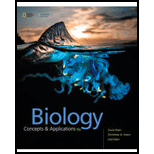
Concept explainers
Which is not a
| a. adenine | c. glutamine | e. cytosine |
| b. guanine | d. thymine | f. All are in DNA. |
Introduction:
DNA is a polymer of nucleotides. Each nucleotide consists of a deoxyribose sugar, three phosphate groups, and a nitrogen-containing base.
Answer to Problem 1SA
Correct answer:
Glutamine is not a nucleotide base in DNA. Hence, the correct answer is option c.
Explanation of Solution
Reason for correct answer:
Option c. is given as “glutamine.”
The four nitrogen bases of DNA are adenine, thymine, cytosine, and guanine. Glutamine is one of the
Reason for incorrect answer:
Option a. is given as, “adenine.”
Adenine is one of the two purine bases that form the nucleotides of DNA. Glutamine is classified under the category of amino acids. Hence, option a. is incorrect.
Option b. is given as, “guanine.”
Guanine is a nitrogenous base that belongs to the purine group. Glutamine is absent in the double-stranded DNA structure. Hence, option b. is incorrect.
Option d. is given as, “thymine.”
Thymine belongs to the pyrimidine group of nitrogen bases of DNA. Glutamine does not belong to the category of pyrimidines. Hence, option d. is incorrect.
Option e. is given as, “cytosine.”
Cytosine is a pyrimidine base in the nucleotides of DNA. Glutamine does not belong to the category of either purines or pyrimidines. Hence, option e. is incorrect.
Option f. is given as, “All are in DNA.”
Adenine, thymine, cytosine, and guanine are the four nitrogenous bases present in the double-helical structure of DNA. However, glutamine does not belong to the category of nitrogenous bases present in the DNA molecule. Hence, option f. is incorrect.
Hence, the options a., b., d., e., and f. are incorrect.
The four nitrogen bases of DNA are adenine, thymine, cytosine, and guanine. Glutamine is an amino acid and is absent in DNA bases. Thus, the correct answer is option c.
Want to see more full solutions like this?
Chapter 8 Solutions
BIOLOGY:CONCEPTS+APPL.(LOOSELEAF)
- Can I please get this answered with the colors and how the R group is suppose to be set up. Thanksarrow_forwardfa How many different gametes, f₂ phenotypes and f₂ genotypes can potentially be produced from individuals of the following genotypes? 1) AaBb i) AaBB 11) AABSC- AA Bb Cc Dd EE Cal bsm nortubaarrow_forwardC MasteringHealth MasteringNu × session.healthandnutrition-mastering.pearson.com/myct/itemView?assignment ProblemID=17396416&attemptNo=1&offset=prevarrow_forward10. Your instructor will give you 2 amino acids during the activity session (video 2-7. A. First color all the polar and non-polar covalent bonds in the R groups of your 2 amino acids using the same colors as in #7. Do not color the bonds in the backbone of each amino acid. B. Next, color where all the hydrogen bonds, hydrophobic interactions and ionic bonds could occur in the R group of each amino acid. Use the same colors as in #7. Do not color the bonds in the backbone of each amino acid. C. Position the two amino acids on the page below in an orientation where the two R groups could bond together. Once you are satisfied, staple or tape the amino acids in place and label the bond that you formed between the two R groups. - Polar covalent Bond - Red - Non polar Covalent boND- yellow - Ionic BonD - PINK Hydrogen Bonn - Purple Hydrophobic interaction-green O=C-N H I. H HO H =O CH2 C-C-N HICK H HO H CH2 OH H₂N C = Oarrow_forwardFind the dental formula and enter it in the following format: I3/3 C1/1 P4/4 M2/3 = 42 (this is not the correct number, just the correct format) Please be aware: the upper jaw is intact (all teeth are present). The bottom jaw/mandible is not intact. The front teeth should include 6 total rectangular teeth (3 on each side) and 2 total large triangular teeth (1 on each side).arrow_forward12. Calculate the area of a circle which has a radius of 1200 μm. Give your answer in mm² in scientific notation with the correct number of significant figures.arrow_forwardDescribe the image quality of the B.megaterium at 1000X before adding oil? What does adding oil do to the quality of the image?arrow_forwardWhich of the follwowing cells from this lab do you expect to have a nucleus and why or why not? Ceratium, Bacillus megaterium and Cheek epithelial cells?arrow_forward14. If you determine there to be debris on your ocular lens, explain what is the best way to clean it off without damaging the lens?arrow_forward11. Write a simple formula for converting mm to μm when the number of mm's is known. Use the variable X to represent the number of mm's in your formula.arrow_forward13. When a smear containing cells is dried, the cells shrink due to the loss of water. What technique could you use to visualize and measure living cells without heat-fixing them? Hint: you did this technique in part I.arrow_forward10. Write a simple formula for converting μm to mm when the number of μm's are known. Use the variable X to represent the number of um's in your formula.arrow_forwardarrow_back_iosSEE MORE QUESTIONSarrow_forward_ios

 Concepts of BiologyBiologyISBN:9781938168116Author:Samantha Fowler, Rebecca Roush, James WisePublisher:OpenStax College
Concepts of BiologyBiologyISBN:9781938168116Author:Samantha Fowler, Rebecca Roush, James WisePublisher:OpenStax College Human Biology (MindTap Course List)BiologyISBN:9781305112100Author:Cecie Starr, Beverly McMillanPublisher:Cengage Learning
Human Biology (MindTap Course List)BiologyISBN:9781305112100Author:Cecie Starr, Beverly McMillanPublisher:Cengage Learning Biology (MindTap Course List)BiologyISBN:9781337392938Author:Eldra Solomon, Charles Martin, Diana W. Martin, Linda R. BergPublisher:Cengage LearningEssentials of Pharmacology for Health ProfessionsNursingISBN:9781305441620Author:WOODROWPublisher:Cengage
Biology (MindTap Course List)BiologyISBN:9781337392938Author:Eldra Solomon, Charles Martin, Diana W. Martin, Linda R. BergPublisher:Cengage LearningEssentials of Pharmacology for Health ProfessionsNursingISBN:9781305441620Author:WOODROWPublisher:Cengage Biology Today and Tomorrow without Physiology (Mi...BiologyISBN:9781305117396Author:Cecie Starr, Christine Evers, Lisa StarrPublisher:Cengage Learning
Biology Today and Tomorrow without Physiology (Mi...BiologyISBN:9781305117396Author:Cecie Starr, Christine Evers, Lisa StarrPublisher:Cengage Learning





